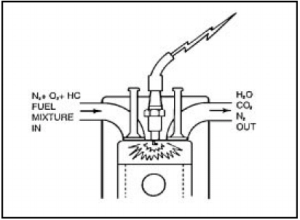Introduction
Whether you are a mechanic, motorcyclist, or car enthusiast, getting the highest performance out of your machine is your top priority. Whether the machine you are working on has a fuel-injection system or is running on a carburetor, a high quality exhaust gas analyzer is an essential tool to have. But before we discuss how our Bridge Exhaust Gas Analyzers can help you tune your engine, let’s first review some combustion fundamentals.
 Bridge Exhaust Gas Analyzer with components
Bridge Exhaust Gas Analyzer with components
COMBUSTION FUNDAMENTALS:
Combustion and Air-Fuel Ratios
In a gasoline-powered internal combustion engine, normal combustion burns a compressed mixture of hydrocarbon fuel and air in the combustion chamber. This action causes the compressed fuel mixture to expand, producing the pressure required to move the pistons downward.
 Combustion Process
Combustion Process
The fuel induction system of a gasoline engine mixes vaporized gasoline, a hydrocarbon, with air in a given proportion. There must be more air than fuel to keep the vaporized fuel in suspension and to supply oxygen for combustion.
The ideal air-fuel ratio for perfect combustion in a gasoline engine is 14.66:1, commonly referred to as 14.7:1. This is the stoichiometric ratio or stoichiometric fuel mixture. Under perfect conditions, the combustion of a stoichiometric air and fuel mixture results in carbon dioxide (CO2), water (H2O) and nitrogen (N2). All of which are harmless. A lean fuel mixture has too much air or too little fuel. A rich fuel mixture has too much fuel or too little air. But as we all know, in the real world nothing is ideal.
 Ideal Combustion Byproducts are H2O, CO2, and N2
Ideal Combustion Byproducts are H2O, CO2, and N2
Combustion Emissions
While stoichiometric ratios are great tools for theorizing, in practice, internal combustion engines are not 100% efficient. Even with ideal fuel mixtures engines cause other substances to form and exhaust from them.
Natural products of combustion are:
Carbon dioxide (CO2) – produce by the oxidation of the carbon contained in the fuel.
Water (H2O) – produced by the oxidation of the hydrogen contained in the fuel.
Secondary constituents of “real-world” combustion exhaust gases include:
Carbon monoxide (CO) – due to incomplete oxidation of Carbon to CO2.
Hydrocarbons (HC) – fuel which has not been oxidized.
Oxides of nitrogen (NOX) – the unwanted combination of Nitrogen with Oxygen.
Oxygen (O2) – unused oxygen from the air.
Because exhaust gases relate to health and environmental concerns as well as to performance, federal and state agencies regulate several of the unwanted “real-world” automobile emissions. While the EPA may not have any use for these combustion exhaust gases, they do serve a purpose for those of us who want to performance tune our machines.
Factory Tuning vs. Performance Tuning
Factory tuned equipment is tuned to meet emissions standards, not to achieve high performance. Usually factory tuning is closer to “ideal” stoichiometric levels in order to meet EPA guidelines for exhaust emissions, which means it is tuned toward the lean side and will necessarily produce less “real-world” exhaust gas. Basically factory tuning is sacrificing performance for efficiency.
On the other hand, performance tuning sacrifices efficiency for power and performance. Machines tuned for performance and power are tuned to the rich side and will therefore exhaust a greater amount of secondary gases (CO, HC, NOx, O2), but they’ll also help you accelerate faster and reach higher top speeds.
Conclusion
Whether you’re tuning for performance or efficiency our series of Bridge Exhaust Gas Analyzers (EGA) are the tools you need to get the most out of whatever machine you’re working on. While you can use them to test for efficiency and EPA compliance, most of our motorcycle and automotive customers use them for performance tuning purposes.

